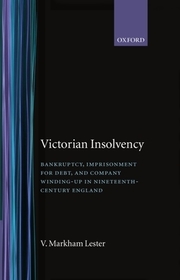
Victorian Insolvency
Bankruptcy, Imprisonment for Debt, and Company Winding-up in Nineteenth-Century England
Series: Oxford Historical Monographs;
- Publisher's listprice GBP 240.00
-
114 660 Ft (109 200 Ft + 5% VAT)
The price is estimated because at the time of ordering we do not know what conversion rates will apply to HUF / product currency when the book arrives. In case HUF is weaker, the price increases slightly, in case HUF is stronger, the price goes lower slightly.
- Discount 10% (cc. 11 466 Ft off)
- Discounted price 103 194 Ft (98 280 Ft + 5% VAT)
Subcribe now and take benefit of a favourable price.
Subscribe
114 660 Ft

Availability
printed on demand
Why don't you give exact delivery time?
Delivery time is estimated on our previous experiences. We give estimations only, because we order from outside Hungary, and the delivery time mainly depends on how quickly the publisher supplies the book. Faster or slower deliveries both happen, but we do our best to supply as quickly as possible.
Product details:
- Publisher Clarendon Press
- Date of Publication 23 February 1995
- ISBN 9780198205180
- Binding Hardback
- No. of pages368 pages
- Size 224x143x24 mm
- Weight 548 g
- Language English
- Illustrations line figures, tables 0
Categories
Short description:
This is the first legal and financial history of bankruptcy in nineteenth-century England. V. Markham Lester offers a full statistical analysis and detailed account of bankruptcy, imprisonment for debt, and company winding-up, and is able to demonstrate the validity of the Victorians' notion that financial failure was a significant problem for English society.
MoreLong description:
This is the first legal and financial history of bankruptcy in nineteenth-century England. V. Markham Lester offers a full statistical analysis and detailed account of bankruptcy, imprisonment for debt, and company winding-up, and traces the decline in the level of insolvency towards the end of the century. His scholarly and detailed analysis demonstrates the validity of the Victorians' notion that financial failure was a significant problem for English society. Dr Lester shows that random factors may have played as great a role as cyclical fluctuations in bankruptcy levels.
Victorian Insolvency also adds a new and significant dimension to the debate on government growth by analysing for the first time the part the English legal system played in the growth of British government. By the end of the nineteenth century, the administration of bankrupt estates was one of the largest items of government expenditure. Dr Lester sets Victorian management of insolvency in the context of other nineteenth-century legal and financial reforms and assesses its role in the development of the modern British state.
The narrative is well written, and incorporates new material. The statistical work is careful to take into account factors that defy precise quantification. This is an attractively presented book that deals with topics that have not received sustained attention elsewhere.










